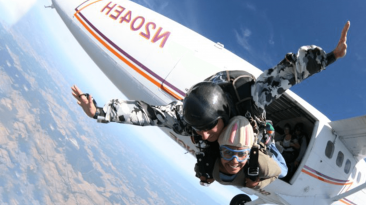Picture this, you’re flying effortlessly over the sea to photograph a pod of dolphins, when all of a sudden, the engine fails on your helicopter. As you plummet erratically earthward, the rotors keep spinning and the pilot struggles to maintain control. Before you know it, you’ve hit the ocean with a tremendous jolt! Within moments, you’re fully submerged. What now?
This is How to Survive a Helicopter Crash.
Helicopters have many unique advantages beyond just getting from point A to point B. They can act as ambulances to help ferry injured people to safety. They fight forest fires from the skies. They allow cinematographers to capture incredible aerial shots, and news agencies use them for traffic updates and to keep track of high speed police chases.
But they can also be a sinking death trap. Unlike a plane, if an engine fails on a helicopter, they can’t always glide their way to a safe landing. Which is why it is imperative as a passenger to know the proper survival techniques in an emergency situation. Before you decide to go tour the Grand Canyon by air or fly to some fancy private island, pay close attention to this video, as there are many safety precautions you should know.
Why are helicopter crashes so dangerous? What should you do if you crash in water? How can you protect your body from impact? In the words of Arnold Schwarzenegger, let’s ‘get to the choppa’ and find out.
Step 1: Train Ahead Of Time
While this video might give you a general overview of what is helpful, please also do yourself a favor and enroll in helicopter survival training. This is especially important if you’re planning to fly over water, as an underwater escape from a helicopter can be very challenging. Luckily, there’s a hands-on course specifically designed for underwater crash scenarios. Helicopter Underwater Escape Training, known as HUET, is provided for flight crews, offshore oil workers, law enforcement and military personnel who are regularly transported over water.
With no wings to help balance the craft, helicopters are prone to roll over quickly and sink rapidly. Training ahead of time has been shown to triple your chance of survival, helping you keep your composure and follow the correct procedures during a crash.
Step 2: Memorize Where Everything Is
If you’re just a regular passenger on a helicopter tour and haven’t done any specialized training in advance, make sure to listen to the pilot carefully and learn where all safety equipment is stowed. Also, memorize your emergency exits. For a water crash, you may lose visibility, become disoriented, and will have to feel your way around.
Step 3: Stay Calm And Brace For Impact
If a helicopter loses power in the air, it can crash at many possible angles. It’s important to know how to brace for impact to reduce any injuries from flailing about. Determine which side might crash first and try to position your body against that part of the helicopter.
For instance, push your head into the surface it’s likely to hit and hold it there to prevent whiplash and any secondary impact. If you’re facing forward, squeeze your lower back firmly against the back of the seat. Lower your chin to your chest and hang onto the edge of the seat with both hands. Or put them under your legs. Do not hang onto the restraint harness as it could break off on impact.
Step 4: Assess The Situation And Leave The Helicopter
After the crash occurs, count slowly to five before leaving the brace position and attempting to exit. These five seconds will allow any debris or projectiles to fly out of harm’s way. They will also help you keep calm and clear-headed. Once you’ve surveyed the damage, locate the nearest emergency exit, unbuckle your seat belt or harness, and get yourself out. If conditions allow, and there’s no rushing water or growing fire in the cabin, try to assist the other passengers if you are physically able.
Step 5: Grab Safety Equipment If You Can
If you’ve crashed in water, grab a life vest and the safety raft. Pronto. If you’re injured, you might have difficulty swimming, so staying afloat is imperative to prevent drowning.
Step 6: Keep Warm And Hydrated
Be sure to keep warm and stay hydrated. It could take several hours before any rescue crews arrive, which is enough time to suffer hypothermia, if you aren’t careful. Sadly, many helicopter crashes can be fatal and there’s little you can do as a passenger. Fortunately, with recent safety developments, any helicopters flying in busy U.S. airspace are mandated by the Federal Aviation Administration to have the Automatic Dependent Surveillance Broadcast system, or ADS-B, installed. This satellite-based technology tracks the helicopter’s exact position, size and direction. Meaning, if anything goes wrong, rescue teams will know exactly where to find you.
Sources
- “How To Survive A Helicopter Crash“. 2014. Air & Space Magazine.
- “What Is A Helicopter?“. 2020. NASA.
- “How Helicopters Work, Fly & Turn (Animation)? – Mechstuff”. 2016. Mechstuff.
- “Five People Die In NYC Helicopter Crash, But The Pilot Survives“.Holly Yan and Eric Levenson, CNN. 2020. CNN.
- “It Happened To Me… I Survived A Helicopter Crash“. Foster, Jill. 2020. Mail Online.


















